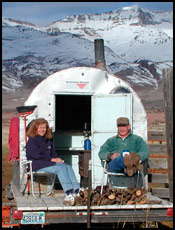
Ron Torell with his wife, Jackie.
Cow Camp Chatter
Forage-based heifer development programs require slow but
steady gain.
Many higher-precipitation regions of the United States produce an abundance of quality forage year-round, requiring little if any supplemental feed to properly develop heifers for breeding. For the rangelands of the arid and semi-arid American West, it's a different story. By fall, these rangelands produce 450- to 500-pound (lb.) weaned spring-born heifer calves. Ranchers often will retain 15%-20% of the heifers as replacements.
In an effort to obtain a 700 lb.-plus target breeding weight by spring, winter development rations generally consist of quality homegrown native hay along with a few pounds per head per day of a grain-based supplement for added energy and protein. This winter ration generally yields an average daily gain (ADG) of 1.25 lb.-1.75 lb., which is more than sufficient to reach the spring target breeding weight.
Due to the severity of the 2012 drought and the effect it has had on the price of grain and grain byproducts, the grain-based method for reaching target breeding weight may now have to be re-evaluated.
Consider options
A processed or standing-forage ration generally results in a lower ADG compared to a grain-based diet. For this reason, reaching target weight requires selecting only those heifers capable of reaching target breeding weight at a reduced ADG during the winter feeding period. Those heifers not meeting the minimum body weight requirements should be sold up front. Retained heifers will need to be fed for a longer period of time at a slower rate, thereby requiring an early initiation date of feeding to meet the breeding weight target.
Compensating for extremely high-priced concentrates and hay requires being creative with winter feeding and grazing. Explore feeding nontraditional quality forages such as crop residues and vegetable-based byproducts as winter feeds. Keep in mind the risks associated with feeding alternative forages. Testing samples of forage for toxic substances as well as quality helps assess the "feedability" and risk associated with feeding nontraditional forms of forages. Toxic substances of particular concern during drought years are nitrates, which can be lethal at high levels.
Corn is king of energy, while alfalfa is king of protein. Relative to obtaining a rapid gain, alfalfa, while being an average energy source, pales in comparison to corn. Quality alfalfa hay is an excellent protein source for a slow but steady heifer development ration. When quality alfalfa is fed in combination with quality native hay or standing forage, sufficient gain can be obtained to reach the target breeding weight provided, as mentioned earlier, the program is initiated early.
Making forages go further
At the onset of heifer development, consider internal and external parasite control. This reduces the nutrient burden placed on growing heifers. Research has clearly shown that the addition of a sound mineral package containing an ionophore (such as Bovatec® or Rumensin®) improves weight gain, aiding in the development and earlier cyclicity of heifers.
Proper management requires weighing replacement heifers throughout the development period and adjusting feeding and management practices so that the target breeding weight is reached. Managers may have to sort off the lighter end of a group of heifers and push this group harder, utilizing a more expensive grain-based ration.
Fall- and winter-grazing replacement heifers on un-grazed fields, regardless of whether vegetation is meadow aftermath or rangeland, will result in increased gains. Research has shown that cows will select a ration higher in protein and energy upon their first introduction into a field because they seek out the lush feed and better plant portions. As time goes by, the quality of the standing forage will decline because the best plants and portions of plants will have been harvested. After the premium is harvested, move replacement heifers to the next un-grazed pasture and bring the cows with lower nutrient demands into the already slightly grazed field.
The genetic selection of cattle has a profound effect on their nutrient demand. Selecting smaller-framed replacement heifers lowers the required target breeding weight. This in turn minimizes the dependency on grain-based rations to reach the target breeding weight. A smaller-framed cow with lower milk production requires less supplementation in her lifetime. This makes her better-suited for a forage-based life.
Calving in harmony with Mother Nature and green grass will better match the cow's needs to feed resources. This reduces the need for supplementation and allows more time on early spring feed for replacement heifers to reach their target breeding weight. Green grass has the added benefit of kick-starting the reproductive factory just prior to breeding.
In summary
The rising cost of grain and hay has significantly increased cost of gain inside and outside of the feedlot. The economic signal has been sent that forage-based gain is required to survive. The high cost of gain has not changed the biological requirement for heifers to be fed to a target breeding weight for timely and early conception; rather, it has dictated changes in management considerations such as mature cow size, feeding practices, time of calving, genetic makeup of the cow herd and forward planning of forage resources. Maintaining proper year-round stocking rates, stockpiling forage for fall and winter use, and reserving the best-quality homegrown hay for use for animals with the highest nutrient demands secures future success.
That's enough for this month. A special thanks to my wife, Jackie, for her part in writing "Cow Camp Chatter." As always, if you would like to discuss this article or simply want to talk cows, do not hesitate to contact me at 775-385-7665 or rtbulls@frontier.com.











